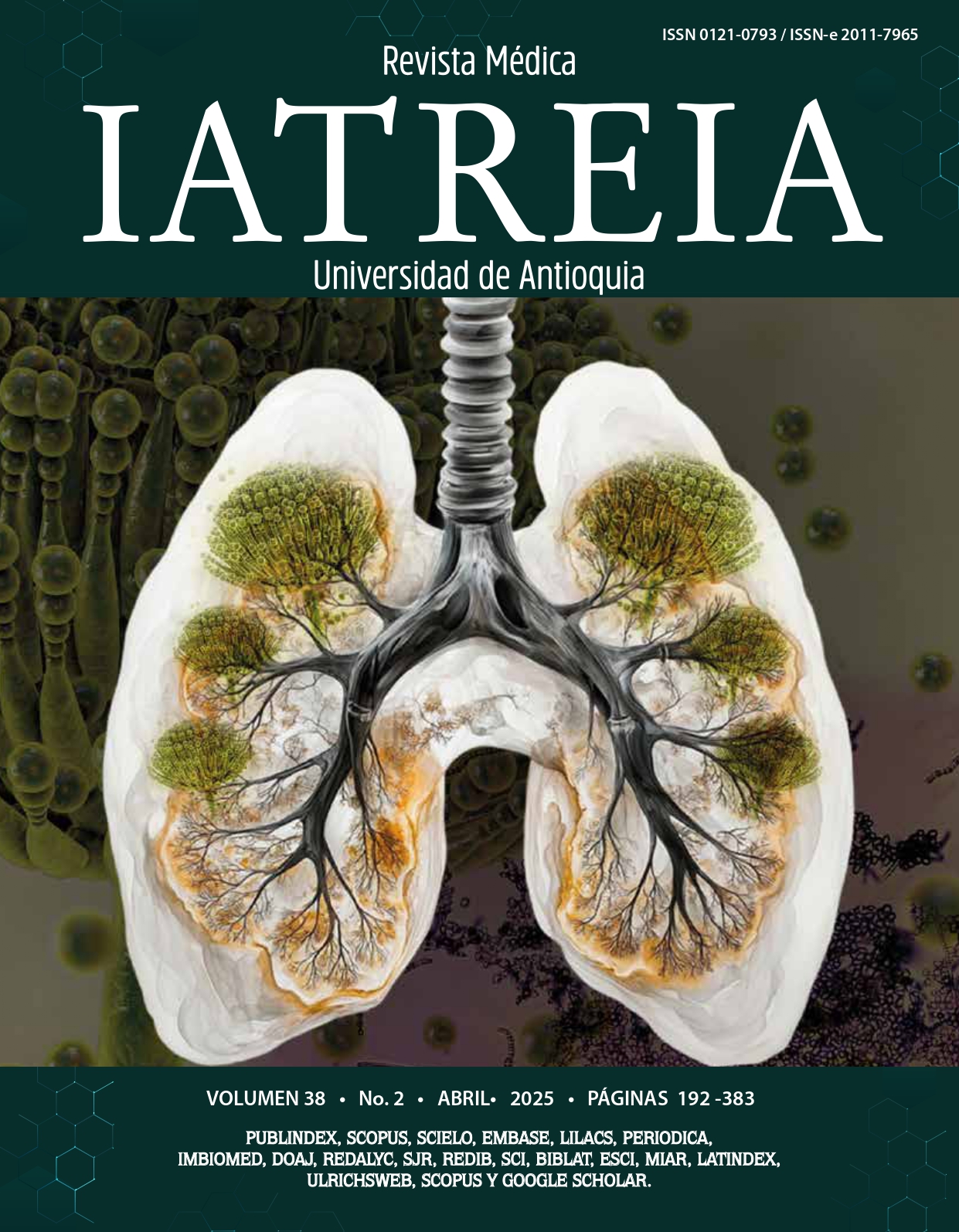Intravenous Analgesic Infusion of Ketamine in the Management of Chronic Inflammatory Pain: A Case Series Analysis
DOI:
https://doi.org/10.17533/udea.iatreia.292Keywords:
Case reports, Chronic pain, Inflammation, Ketamine, Pain managementAbstract
Introduction: Despite the paucity of evidence regarding the management of inflammatory pain, the potential impact of ketamine on its pathophysiology has been increasingly recognized, primarily based on preclinical studies.
Objectives: To describe the effect of intravenous subanesthetic-dose ketamine infusion on the control of inflammatory pain.
Methodology: A case series review was conducted, including patients over 18 years of age with inflammatory pain requiring subanesthetic dose ketamine infusion.
Results: Seventeen patients were recruited. Upon admission, 52.9% presented with severe pain, 41.2% with moderate pain, and 5.9% with mild pain. The median duration of ketamine infusion was 59 hours. All patients experienced a reduction in pain intensity, and no significant adverse events were observed.
Conclusions: Subanesthetic dose ketamine infusion reduced pain intensity without significant adverse effects. These results highlight the therapeutic potential of this medication in the treatment of chronic inflammatory pain.
Downloads
References
(1) Peltoniemi MA, Hagelberg NM, Olkkola KT, Saari TI. Ketamine: A Review of Clinical Pharmacokinetics and Pharmacodynamics in Anesthesia and Pain Therapy. Clin Pharmacokinet [Internet]. 2016;55(9):1059-77. http://www.doi.org/10.1007/s40262-016-0383-6
(2) Hirota K, Lambert DG. Ketamine: new uses for an old drug? Br J Anaesth [Internet]. 2011;107(2):123-6. http://www.doi.org/10.1093/bja/aer221
(3) Zanos P, Moaddel R, Morris PJ, Riggs LM, Highland JN, Georgiou P, et al. Ketamine and Ketamine Metabolite Pharmacology: Insights into Therapeutic Mechanisms. Pharmacol Rev [Internet]. 2018;70(3):621-660. http://www.doi.org/10.1124/pr.117.015198
(4) Motov S, Mai M, Pushkar I, Likourezos A, Drapkin J, Yasavolian M, et al. A prospective randomized, double-dummy trial comparing IV push low dose ketamine to short infusion of low dose ketamine for treatment of pain in the ED. Am J Emerg Med [Internet]. 2017;35(8):1095-1100. http://www.doi.org/10.1016/j.ajem.2017.03.004
(5) Yam MF, Loh YC, Tan CS, Adam SK, Abdul-Manan N, Basir R. General Pathways of Pain Sensation and the Major Neurotransmitters Involved in Pain Regulation. Int J Mol Sci [Internet]. 2018;19(8):2164. http://www.doi.org/10.3390/ijms19082164
(6) Costigan M, Scholz J, Woolf CJ. Neuropathic pain: a maladaptive response of the nervous system to damage. Annu Rev Neurosci [Internet]. 2009;32:1-32. http://www.doi.org/10.1146/annurev.neuro.051508.135531
(7) Latremoliere A, Woolf CJ. Central sensitization: a generator of pain hypersensitivity by central neural plasticity. J Pain [Internet]. 2009;10(9):895-926. http://www.doi.org/10.1016/j.jpain.2009.06.012
(8) Culp C, Kim HK, Abdi S. Ketamine Use for Cancer and Chronic Pain Management. Front Pharmacol [Internet]. 2021;11:599721. http://www.doi.org/10.3389/fphar.2020.599721
(9) Deng M, Chen SR, Pan HL. Presynaptic NMDA receptors control nociceptive transmission at the spinal cord level in neuropathic pain. Cell Mol Life Sci [Internet]. 2019;76(10):1889-1899. http://www.doi.org/10.1007/s00018-019-03047-y
(10) Cohen SP, Bhatia A, Buvanendran A, Schwenk ES, Wasan AD, Hurley RW, et al. Consensus Guidelines on the Use of Intravenous Ketamine Infusions for Chronic Pain From the American Society of Regional Anesthesia and Pain Medicine, the American Academy of Pain Medicine, and the American Society of Anesthesiologists. Reg Anesth Pain Med [Internet]. 2018;43(5):521-546. http://www.doi.org/10.1097/AAP.0000000000000808
(11) Loix S, De Kock M, Henin P. The anti-inflammatory effects of ketamine: state of the art. Acta Anaesthesiol Belg [Internet]. 2011;62(1):47-58. Available from: https://pubmed.ncbi.nlm.nih.gov/21612145/
(12) Boettger MK, Weber K, Gajda M, Brauer R, Schaible HG. Spinally applied ketamine or morphine attenuate peripheral inflammation and hyperalgesia in acute and chronic phases of experimental arthritis. Brain Behav Immun [Internet]. 2010;24(3):474-485. http://www.doi.org/10.1016/j.bbi.2009.12.002
(13) Lu W, Wang L, Wo C, Yao J. Ketamine attenuates osteoarthritis of the knee via modulation of inflammatory responses in a rabbit model. Mol Med Rep [Internet]. 2016;13(6):5013-20. http://www.doi.org/10.3892/mmr.2016.5164
(14) Wang J, Zhao Q, Zhou Y, Sun W, Han S, Peng Y, et al. Subanesthetic Dose of Ketamine Improved CFA-induced Inflammatory Pain and Depression-like Behaviors Via Caveolin-1 in Mice. J Neurosurg Anesthesiol [Internet]. 2020;32(4):359-366. http://www.doi.org/10.1097/ANA.0000000000000610
(15) Fan QQ, Li L, Wang WT, Yang X, Suo ZW, Hu XD. Activation of α2 adrenoceptors inhibited NMDA receptor-mediated nociceptive transmission in spinal dorsal horn of mice with inflammatory pain. Neuropharmacology [Internet]. 2014;77:185-92. http://www.doi.org/10.1016/j.neuropharm.2013.09.024
(16) Welters ID, Hafer G, Menzebach A, Mühling J, Neuhäuser C, Browning P, et al. Ketamine inhibits transcription factors activator protein 1 and nuclear factor-κB, interleukin-8 production, as well as CD11b and CD16 expression: Studies in human leukocytes and leukocytic cell lines. Anesth Analg [Internet]. 2010;110(3):934–41. http://www.doi.org/10.1213/ANE.0b013e3181c95cfa
(17) Hattori Y, Hattori K, Suzuki T, Palikhe S, Matsuda N. Nucleic-acid based gene therapy approaches for sepsis. Eur J Pharmacol [Internet]. 2018;833:403–10. http://www.doi.org/10.1016/j.ejphar.2018.06.031
(18) Lee S-K, Na S-Y, Jung S-Y, Choi J-E, Jhun BH, Cheong J, et al. Activating protein-1, nuclear factor-κB, and serum response factor as novel target molecules of the cancer-amplified transcription coactivator ASC-2. Mol Endocrinol [Internet]. 2000;14(6):915–25. https://doi.org/10.1210/mend.14.6.0471
(19) Hanna AF, Abraham B, Hanna A, McKenna M, Smith AJ. Intravenous ketamine alleviates pain in a rheumatoid arthritis patient with comorbid fibromyalgia. J Med Cases [Internet]. 2018;9(5):142–4. http://www.doi.org/10.14740/jmc3017w
(20) Pastrak M, Abd-Elsayed A, Ma F, Vrooman B, Visnjevac O. Systematic Review of the Use of Intravenous Ketamine for Fibromyalgia. Ochsner J [Internet]. 2021;21(4):387-394. http://www.doi.org/10.31486/toj.21.0038
(21) Posada-Giraldo C, Herrera-Mondragón MA, Joaquí-Tapia WH. Using ketamine in a pediatric patient with a pain crisis in juvenile idiopathic arthritis. A case report. Rev Colomb Anestesiol [Internet]. 2018;46(2S):74–77. http://www.doi.org/10.1097/CJ9.0000000000000049
(22) Rasmussen KG. Psychiatric side effects of ketamine in hospitalized medical patients administered subanesthetic doses for pain control. Acta Neuropsychiatr [Internet]. 2014;26(4):230-233. http://www.doi.org/10.1017/neu.2013.61
(23) Maneglia R, Cousin MT. A comparison between propofol and ketamine for anaesthesia in the elderly. Haemodynamic effects during induction and maintenance. Anaesthesia. 1988;43(suppl): 109–111. http://www.doi.org/10.1111/j.1365-2044.1988.tb09090.x
Published
How to Cite
Issue
Section
License
Copyright (c) 2024 Iatreia

This work is licensed under a Creative Commons Attribution-NonCommercial-ShareAlike 4.0 International License.
Papers published in the journal are available for use under the Creative Commons license, specifically Attribution-NonCommercial-ShareAlike 4.0 International.
The papers must be unpublished and sent exclusively to the Journal Iatreia; the author uploading the contribution is required to submit two fully completed formats: article submission and authorship responsibility.














